I've previously discussed the early development of the ammunition used in naval guns, but in the 1880s, developments in armor and fusing quickly left those early projectiles behind. Soon, improved versions of both shot (simple chunks of metal) and shell, with explosive fillings, were being put into service.
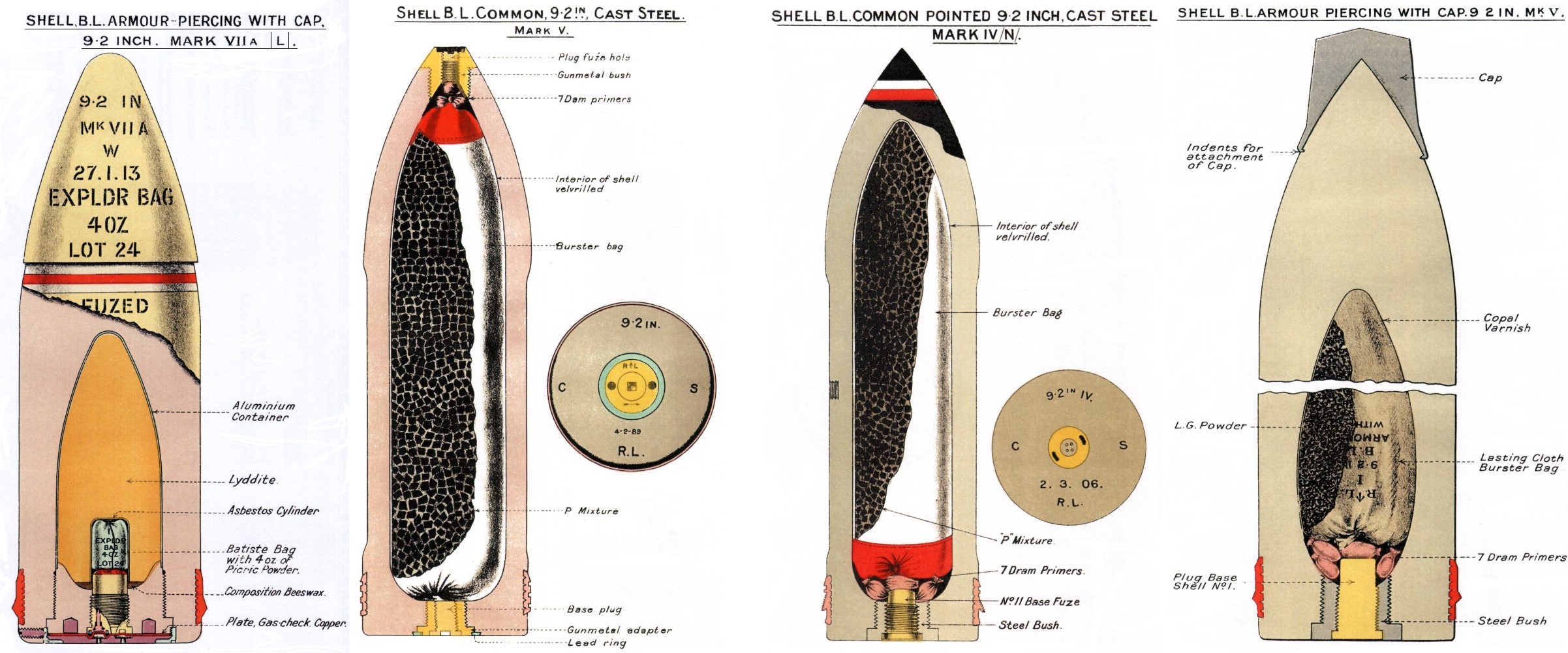
A selection of 9.2" shells
The cast-iron Palliser Shot had been effective enough against wrought iron, but it was easily shattered by better armor. The obvious choice was to switch to steel projectiles, but the chilled hardening process didn't work with cast steel.1 In fact, cast steel was not particularly suitable for Armor-Piercing (AP) shot or shells, and projectiles had to be forged instead.2 Steel was poured into a die in the rough shape of the shell, but somewhat larger. Once the shell blank solidified, it was moved to another furnace, and then steam hammers or a hydraulic press were used to work it against a die, producing a shape close to the final shell. It was then annealed by heating in a furnace for several days to relieve any undesirable stress concentrations, and machined down to the final shape. The shell was forged with the nose closed and the base open, and after the base cavity was bored to the desired size, the opening was threaded to accept the base plug.
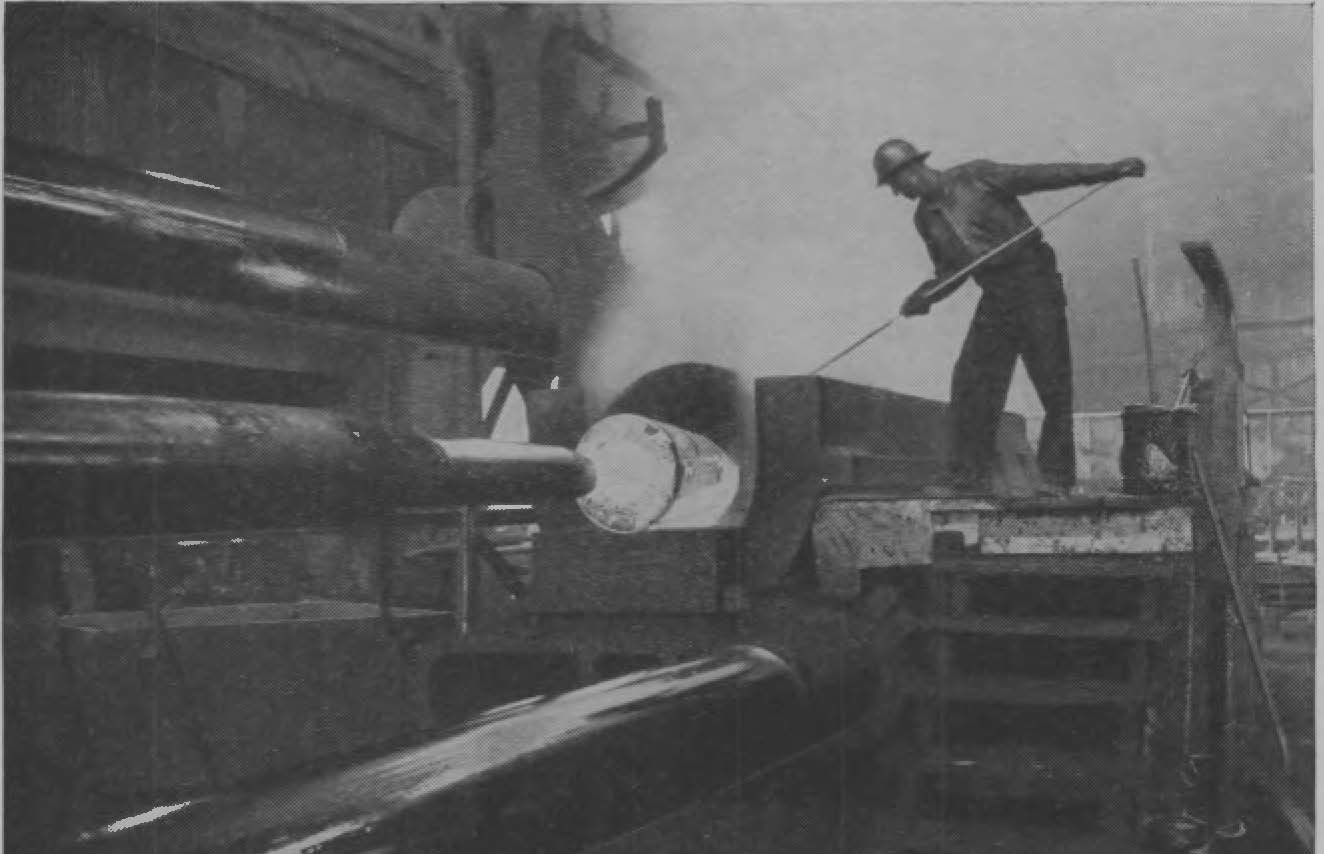
Shell production
At this point, the shell might be scored to hold the cap, which we will come to later, and then it would be subjected to the hardening process. This was quite similar to the processes used to harden armor, with specific operations, ranging from baths in molten lead to quenches in cold water, performed to heat-treat certain parts of the shell and increase their hardness, while other portions of the shell were left softer, but tough and strong. It was then machined again, to make sure it was precisely the right shape, and the driving band, which engaged the rifling, was fitted. The cap might be fitted at this point, and then the shell would be filled and the base plug fitted. Shells were subjected to rigorous tests, ranging from metallurgical analysis to the proof firing of a few randomly-selected shells from each batch against a specified armor plate to ensure that the projectile actually functioned as designed.3
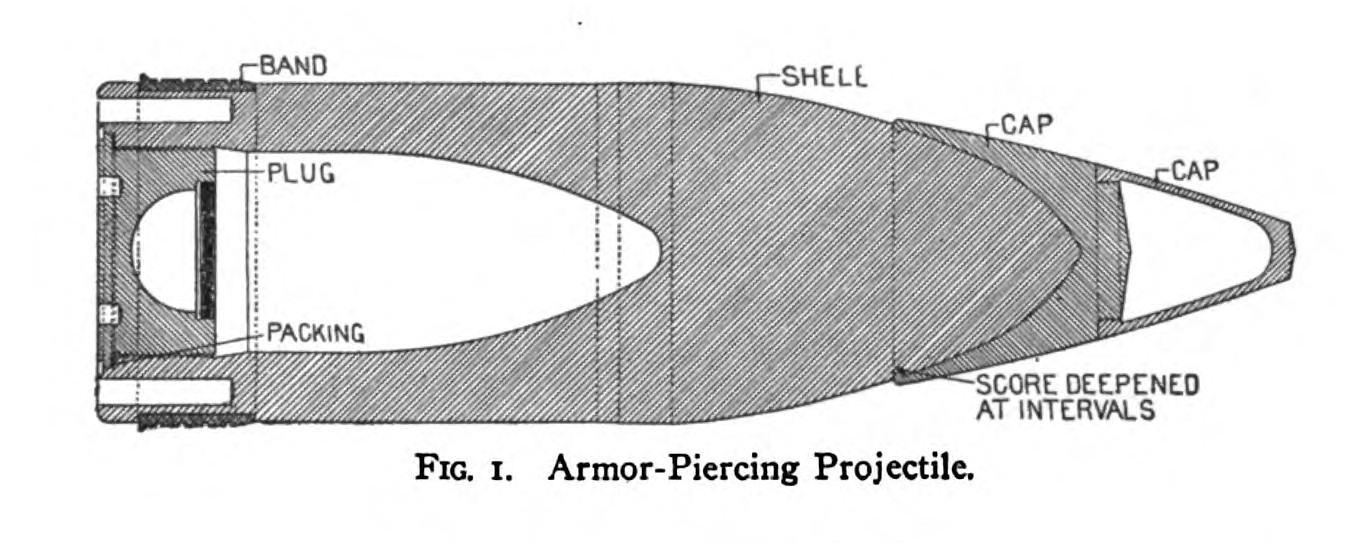
A capped Armor-Piercing shell4
Even a forged-steel shell would usually shatter on impact with face-hardened armor, although an accident during an 1878 shell trial showed how to deal with this.5 A plate of composite armor6 was installed the wrong way around, and the shell penetrated easily. When it was reversed, it was discovered that a thin plate of wrought iron over the steel allowed the shell to penetrate. An officer suggested using a soft cap of wrought iron on the shell to gain the same effect, but for some reason this was ignored until the Russians tried it in 1894. Over the next decade, most navies began to work on caps, and the resulting shells became known as APC, for Armor Piercing Capped.7 The early caps worked by essentially cushioning the shock of impact, keeping the shell's nose from being deflected or shattered by the face-hardened layer, giving approximately 15% improvement in penetration over uncapped shells, so long as obliquity was below about 15°. Above this, they would often be torn away before functioning. They were usually soldered on, using a low-temperature solder guaranteed to not change the heat treatment in the nose. A few navies had small pits in the nose which the cap was crimped into, used instead of or alongside solder. Krupp, which made most German shells, was unique in using a high-temperature solder which seems to have made its caps significantly harder to knock off during an oblique impact.
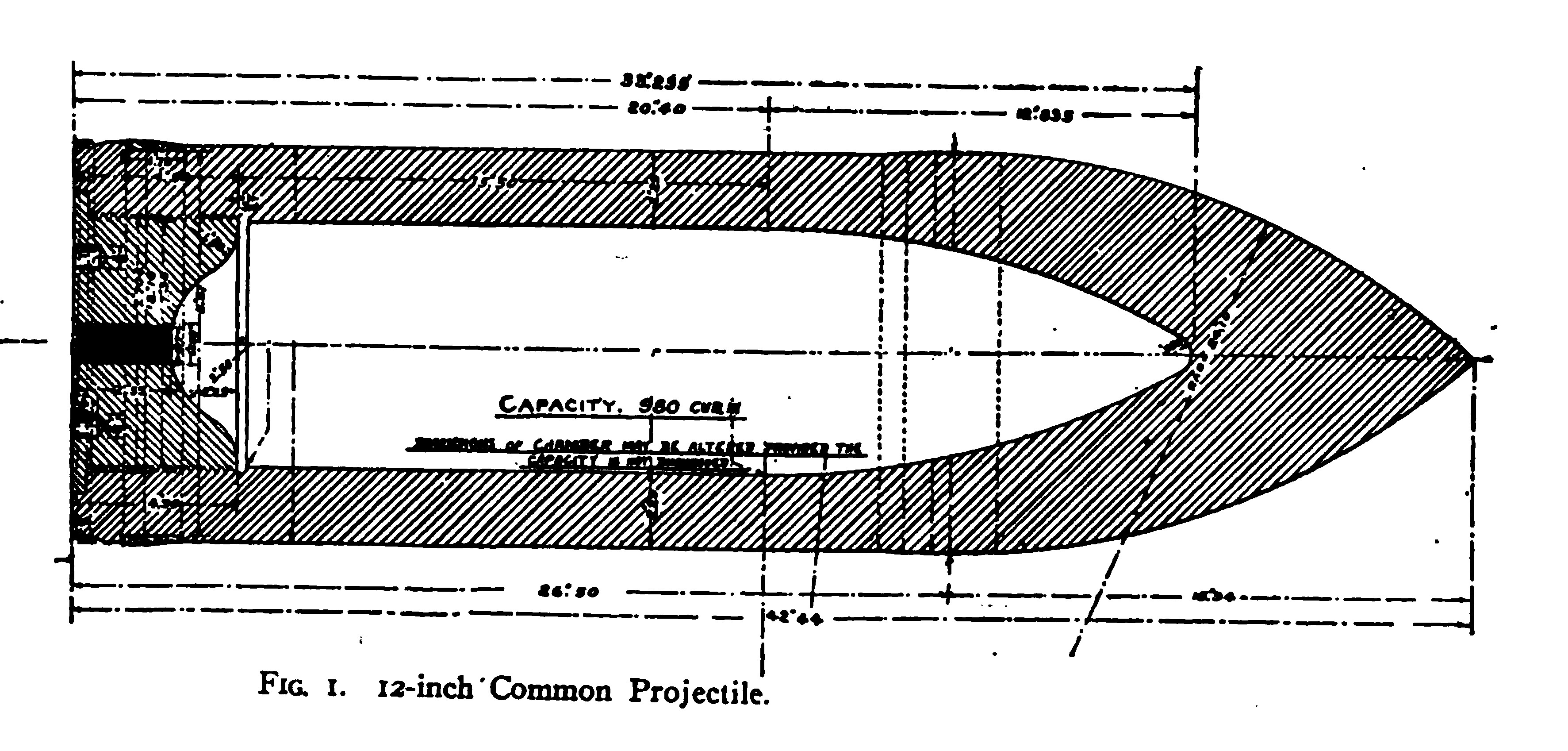
The first decade of the 20th century saw the final demise of shot, as explosives and fuzes8 were developed that could at least theoretically penetrate armor before detonating, and from then on, AP projectiles were universally shell, with a typical explosive filling of about 2%. Besides the old standby, black powder, guncotton and picric acid, known by the British as lyddite, became common in the early days. Lyddite was rather too sensitive to be truly effective, with a nasty tendency to go off while the shell was still going through the armor, which limited effectiveness.9 It tended to produce vast clouds of very small splinters, which were effective against personnel and could do great damage to unarmored portions of the ship, but were not as good at doing structural damage as the larger fragments of a powder-filled shell, which were also better at starting fires aboard the target. The British also claimed that lyddite produced fumes which could overwhelm the enemy crew, although this doesn't seem to have worked particularly well in action. They also changed their nomenclature, keeping Common as the designation for powder-filled shells, while the more powerful fillings were called HE (high-explosive). Both types of shells carried a filling of 12-15% of explosive, and were usually nose-fuzed to go off on impact. The problem was that even quite light armor was able to defeat these shells, and so some nations created Semi-Armor Piercing (SAP) shells. While an AP shell would be expected to penetrate a full caliber of armor, an SAP shell would usually pierce about half that, with 7.5-9% explosive by weight, and be set off with a base fuze, much like an APC shell.10
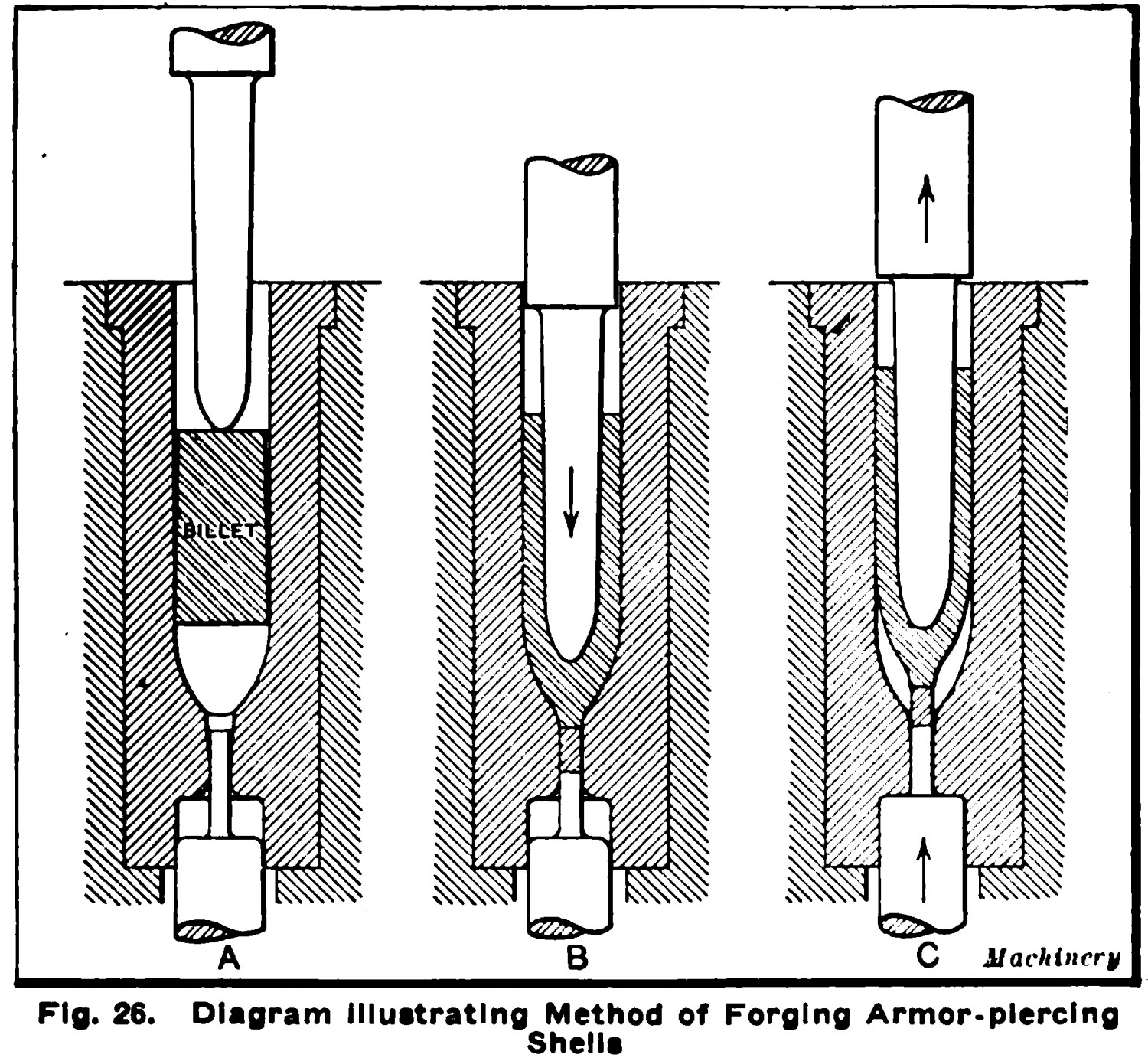
Around 1905, the capped shell looked set to revolutionize naval warfare. At the short ranges typical of the day, it could easily penetrate any belt armor a ship could practically carry. Armor was still useful against HE shells, but in practical terms, there probably wouldn't be a lot of difference between the 11" belt of Dreadnought and the 6" belt on the early battlecruisers. Over the next few years, improvements in fire control saw expected battle ranges rise quickly, to the point where even capped projectiles could be defended against, particularly due to the limitations of early caps in oblique impacts.
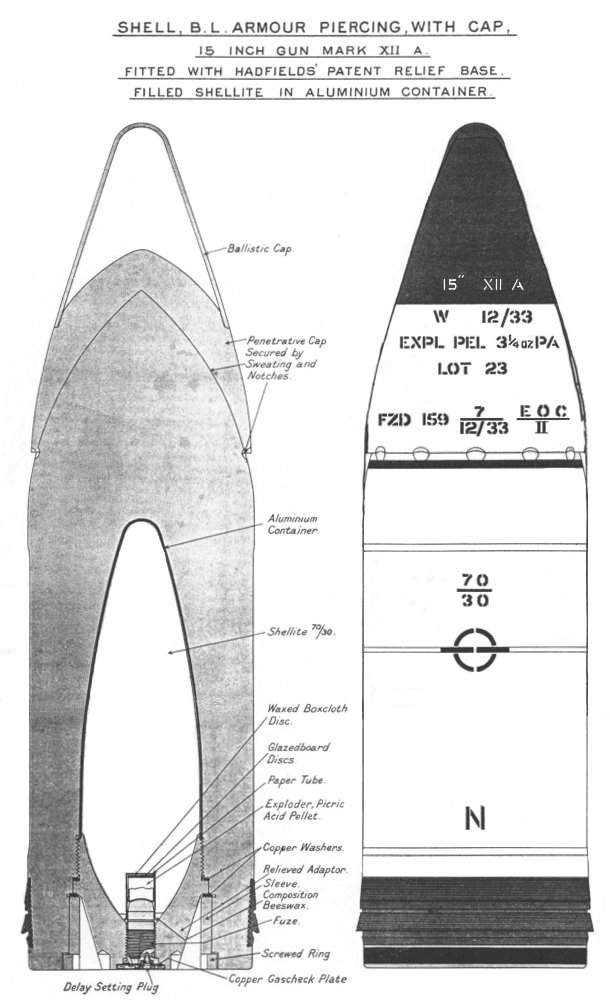
A 15" shell with both armor-piercing and ballistic caps
Another important innovation during this period was the ballistic cap, also known as the windscreen, which allowed shell designers to reconcile the demands of aerodynamics with the best shape for armor penetration. Sharply-pointed shells were not particularly effective at penetrating armor, probably because the long nose tended to break under the impact, but a blunt shell would have excessive drag. The ballistic cap was nothing more than a light steel windscreen to give the shell a better shape. On impact, it would simply be destroyed, leaving the regular cap and main body of the shell to penetrate the armor. Sometimes the presence of a ballistic cap is shown in shell designations as a BC, such as APCBC, but this is far more common for shells for land-based guns, as they were nearly universal for naval AP shells.
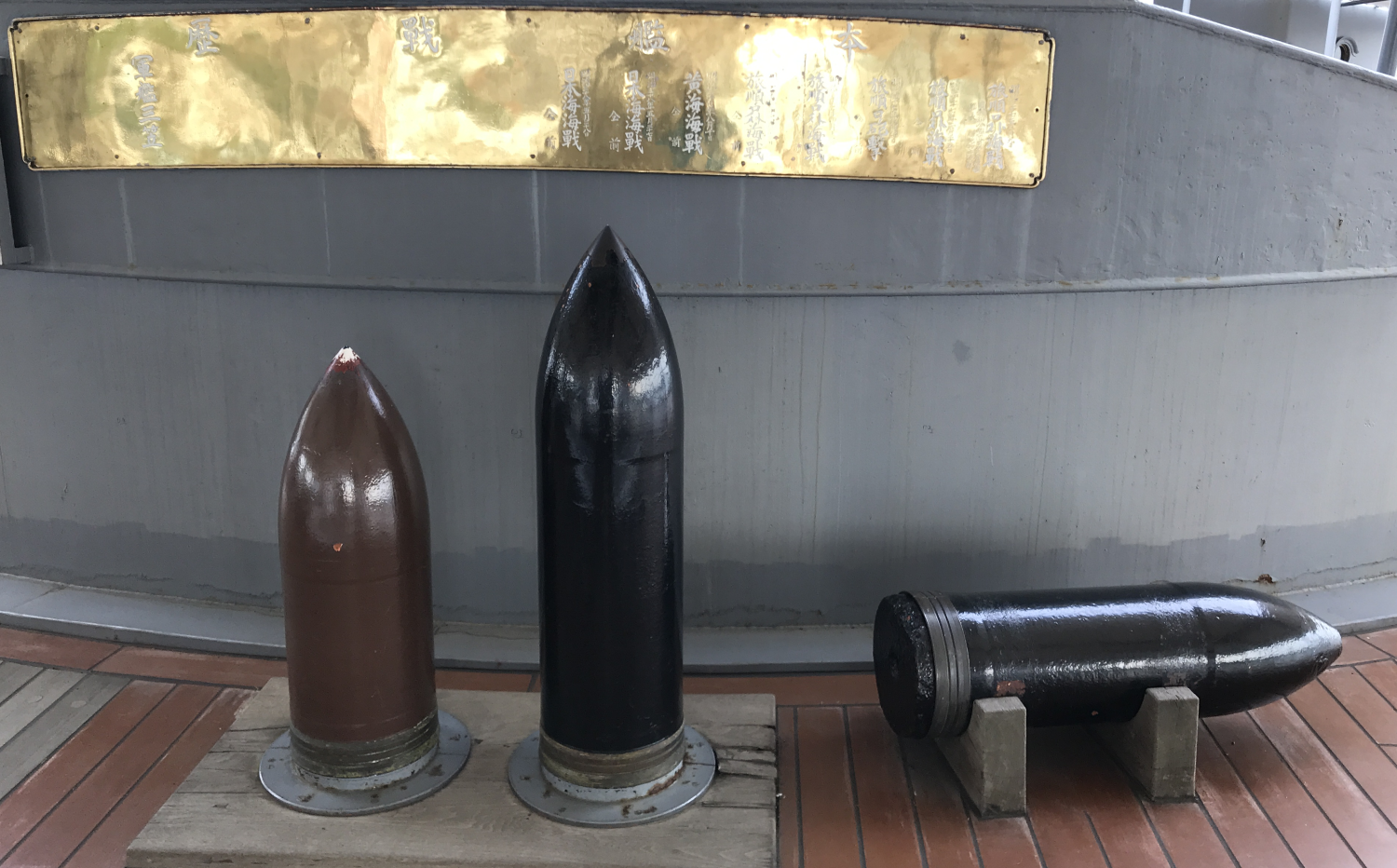
Shells aboard Mikasa11
This was more or less where matters stood at the start of the First World War, although there was considerable national variation. The US fitted its battleships with only APC shells filled with dunnite, while the British planned to use a 50/50 mixture of lyddite-filled APC and powder-filled CPC, as well as some shrapnel shells for defense against torpedo craft.12 The Germans had been early pioneers in introducing TNT, which was more stable than lyddite and considerably less likely to detonate from the impact with the plate. However, it required a more complicated fuze incorporating a booster, as TNT can't bet set off by a simple detonator. This complication caused the British to stick with lyddite despite the safety hazards.
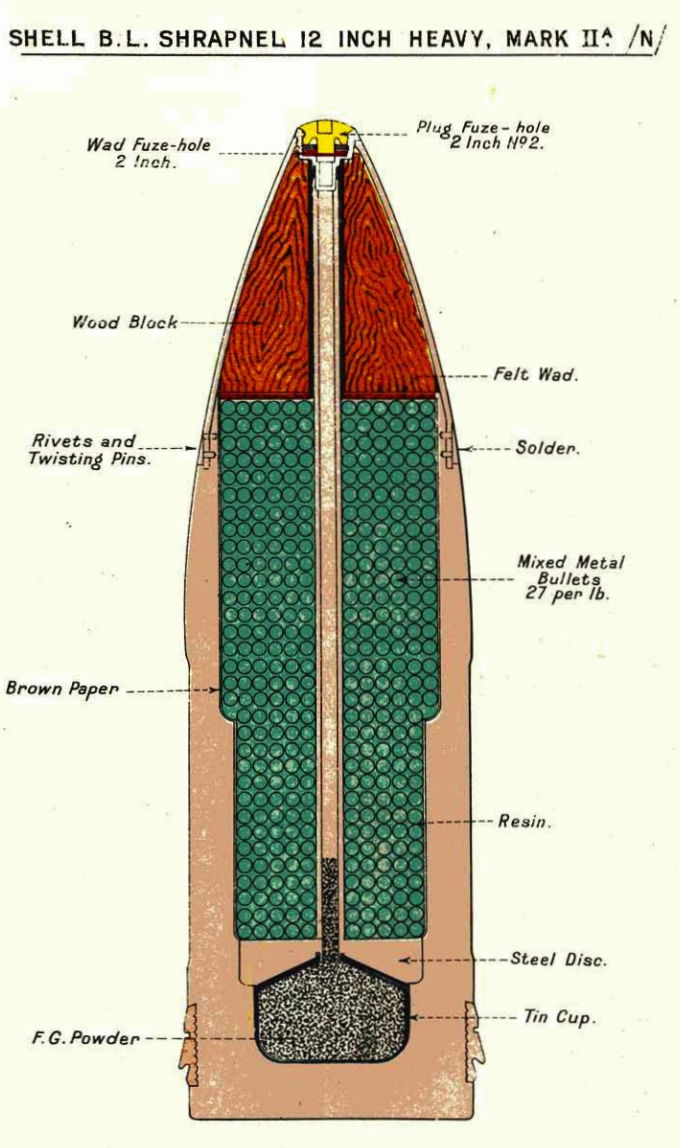
The First World War would put these shells to the test, and reveal that many had glaring deficiencies in combat effectiveness. How these problems were overcome, and the longer-term development of the heavy shell, will be our topic for next time.
1 The exact reasons for this are a matter of really complicated metallurgy, and not something I'm qualified to talk about. My materials class was years ago, and my professor was dreadful. Also, because I'm an aerospace engineer, we spent most of the time talking about things like aluminum and titanium, which are totally irrelevant to battleships. Nathan Okun has a bunch of stuff on armor/shell-related metallurgy here. At some point, I may go into this in more detail, but that will be a different post. ⇑
2 This bit, I do understand, at least in general terms. The act of forging, beating reasonably hot steel into a given shape, induces structural changes into the metal which make it stronger than a cast part. ⇑
3 There was also great emphasis placed on uniformity among the projectiles, especially as battle ranges increased in the runup to WWII. At one point, Russian shell manufacturers were allowed to design their own shells within a general envelope, and the different shapes they chose obviously made fire control nearly impossible. This practice was ended around 1900. ⇑
4 Note the gap in the cap, which allows it to function as both an AP shell cap and a ballistic cap. This idea didn't last very long. ⇑
6 Steel on the front for hardness, wrought iron on the back for toughness. ⇑
7 As capped projectiles became ubiquitous for heavy guns, particularly after WWI, the designation AP was often applied to AP shells with caps. For later naval shells, don't assume the lack of a C means that the projectile doesn't have a cap. ⇑
8 As before, fuzes are outside the scope of this post. The brief version is that these shells used base fuzes, inserted into the back of the shell, instead of the nose fuzes used in Common shells. These were also known sometimes as inertia fuzes, detonating when the shell hit the target and slowed down rapidly. A delay element was also included between the fuze and the explosive filling to make sure the shell was inside the target before going off. Sometimes it worked. ⇑
9 I'm not sure exactly how much of an effect this had. Even if the shell was still in the middle of the plate, a lot of the fragments would end up on the backside of the armor, which is better than nothing ending up back there. But it's worse than a shell going off behind the armor, because less of the fragments were back there, and because the longer fuze gave a higher chance of the shell going off amid the really important stuff. ⇑
10 The British called theirs CPC, for Common Piercing Capped. American shells with bursting charges of this size were known as Common, whether or not they had a cap. Shells with more than 10% explosive were known as HC, for high-capacity. Most nations didn't make an AP projectile for guns of 5" and below, preferring to keep SAP/Common at the top of the range. Nomenclature on this stuff is very messy. ⇑
11 Photo courtesy of Lord Nelson. Mikasa's guns had Common and AP shells, but I'm rather confused by the different lengths of the shells. This was rare, and my references suggest that Mikasa was not an exception. The brown shell on the left looks more like the ones I have in other photos of this gun, but overall, I'm rather confused on this. ⇑
12 This was heavily influenced by the Japanese experience during the Russo-Japanese War. The Russians made heavy use of AP shells filled with wet guncotton, which penetrated, but often failed to go off. The Japanese used mostly powder-filled common after their lyddite-filled AP failed at the Yellow Sea early in the war. While they failed to penetrate heavy armor, they were very effective in damaging and setting aflame the vulnerable upperworks of Russian battleships. ⇑

Comments
Shells are not just simple objects; they're complicated machines that do a great deal of stuff.
Hope you can eventually get around to what modern (post-1980) shell design looks like. Or is that sort of stuff still classified?
That might happen at some point, although my sources on that aren't as good as they are for battleship stuff. And yes, they're very complex machines, even if they don't look it.
Your comment on which materials you are familiar with leads me to ask if you have any insight into something I'm curious about. I'd been under the impression that the extremely limited use of titanium in naval applications was due to cost (especially the cost of the techniques required to work with it). Is that the whole story, or are there other ways in which titanium is unsuitable to naval applications?
That's the only reason I know of. To a first approximation, naval applications are a lot more weight-insensitive than aerospace ones, to the point that it almost never makes sense to use something as expensive as titanium. Corrosion isn't likely to be a big issue, and that's the big killer at sea.
There's actually a fun naval-related story from materials class.
My professor wasn't good. He was a boring lecturer, structured the homework in a horrible manner, and insisted on mandatory attendence, even though it was my only class MWF that semester, and it was at 8 AM. But the most annoying this was his examples, which were usually wrong. One particularly bad week, he gave three. One was getting some details of United 232 wrong, like claiming that all the crew died, which particularly vexed me at the time, because it was so easy to look up.
The other two were naval-related and more subtle. First, he said that the Soviets had adopted titanium hulls for their submarines because it was non-magnetic, and that this frustrated a deep-sea magnetic surveillance effort on the part of the US, so we then built SOSUS. I had to do a bit of research to confirm this was wrong. I think there's a second steel hull on the Soviet submarines, and magnetic detectors only work at very short range. It's particularly annoying because the Germans actually use special steel in their submarine hulls to thwart magnetic detection, which would have been a better example.
The other was when he claimed that a landlocked South American country had bought battleships, and had docked them in some friendly port. They then discovered that the armored doors had suffered from creep. This was also wrong on two counts. First, no landlocked South American country ever bought battleships. Again, I double-checked this, but was able to confirm it wasn't true. Second, creep doesn't work that way in armor steel. I can testify to that personally.
@Protagoras
I think it is not only cost but the difficulty of titanium metalwork, which drives up cost again and limits the ways you can use the material. Apparently there has been some interest in exploring titanium for naval applications despite this, as it seems to be highly resistant to corrosion:
https://www.onr.navy.mil/en/Media-Center/Press-Releases/2012/Titanium-Ship-Hull-Navy-ONR
I remember reading that the Soviets said it would have been cheaper to build their titanium-hulled subs from gold because of the fabrication problems. It's gotten better since then, but it's still expensive. I doubt we'll see much in the surface fleet. Subs are a very different matter, where cheap enough will come much sooner.